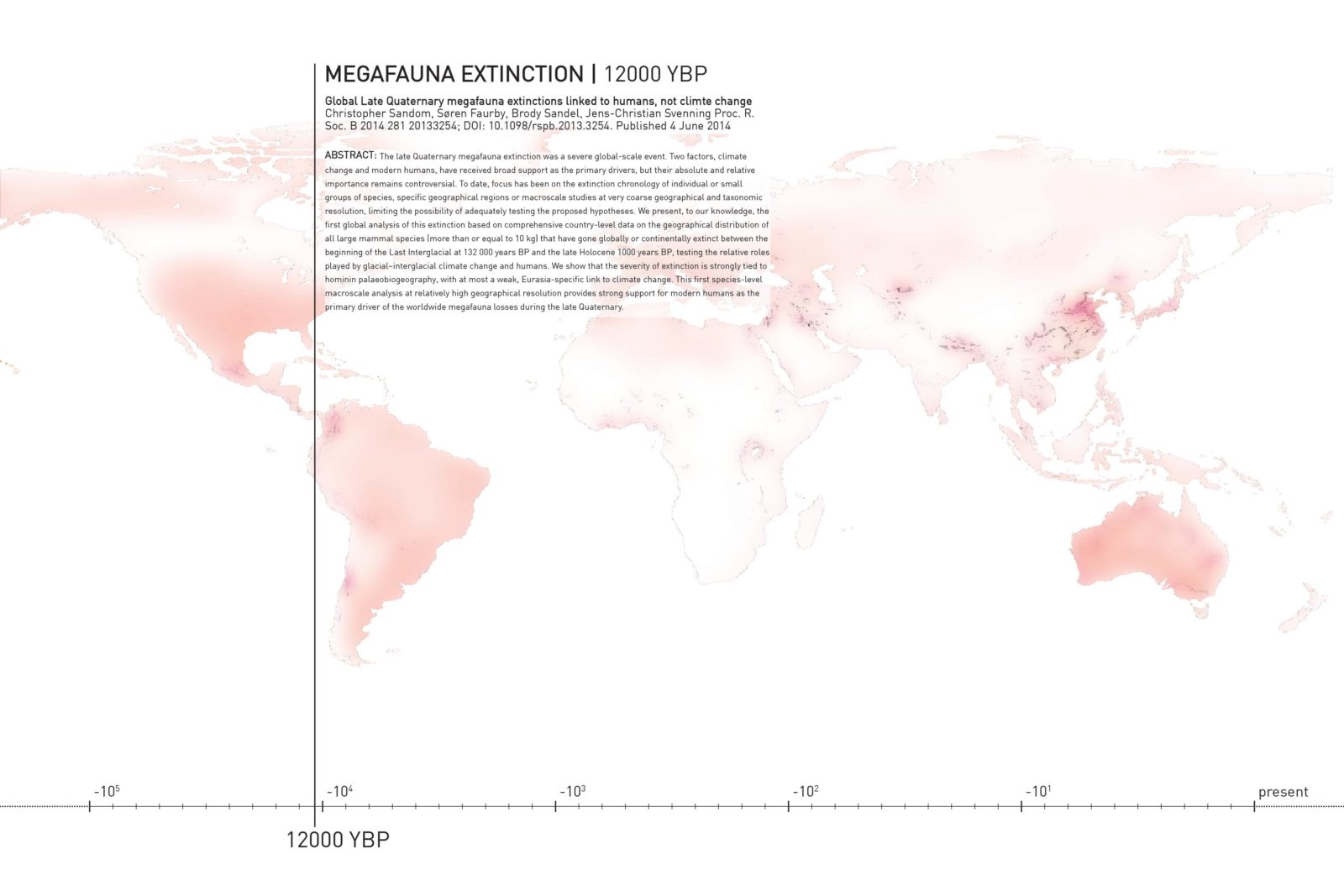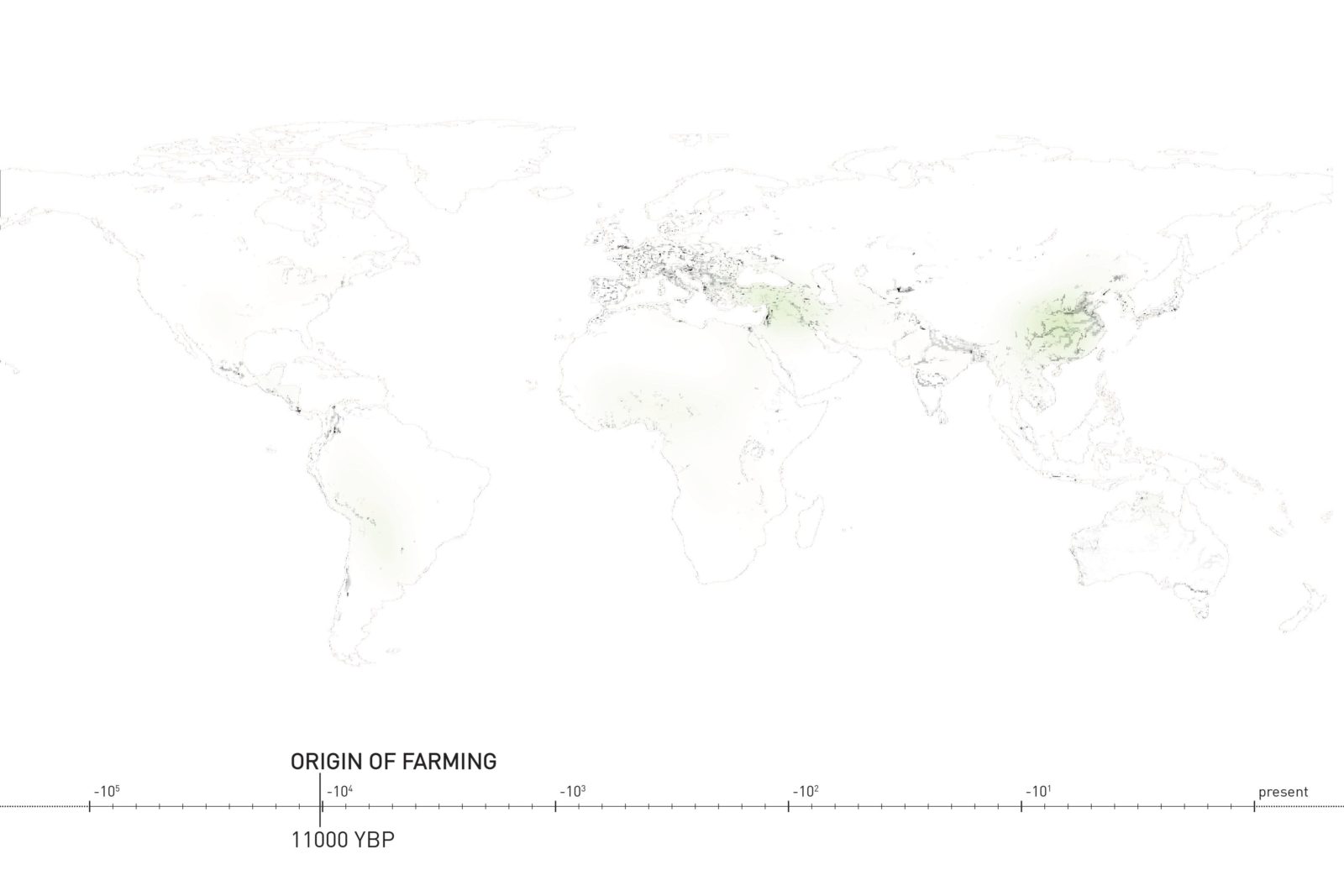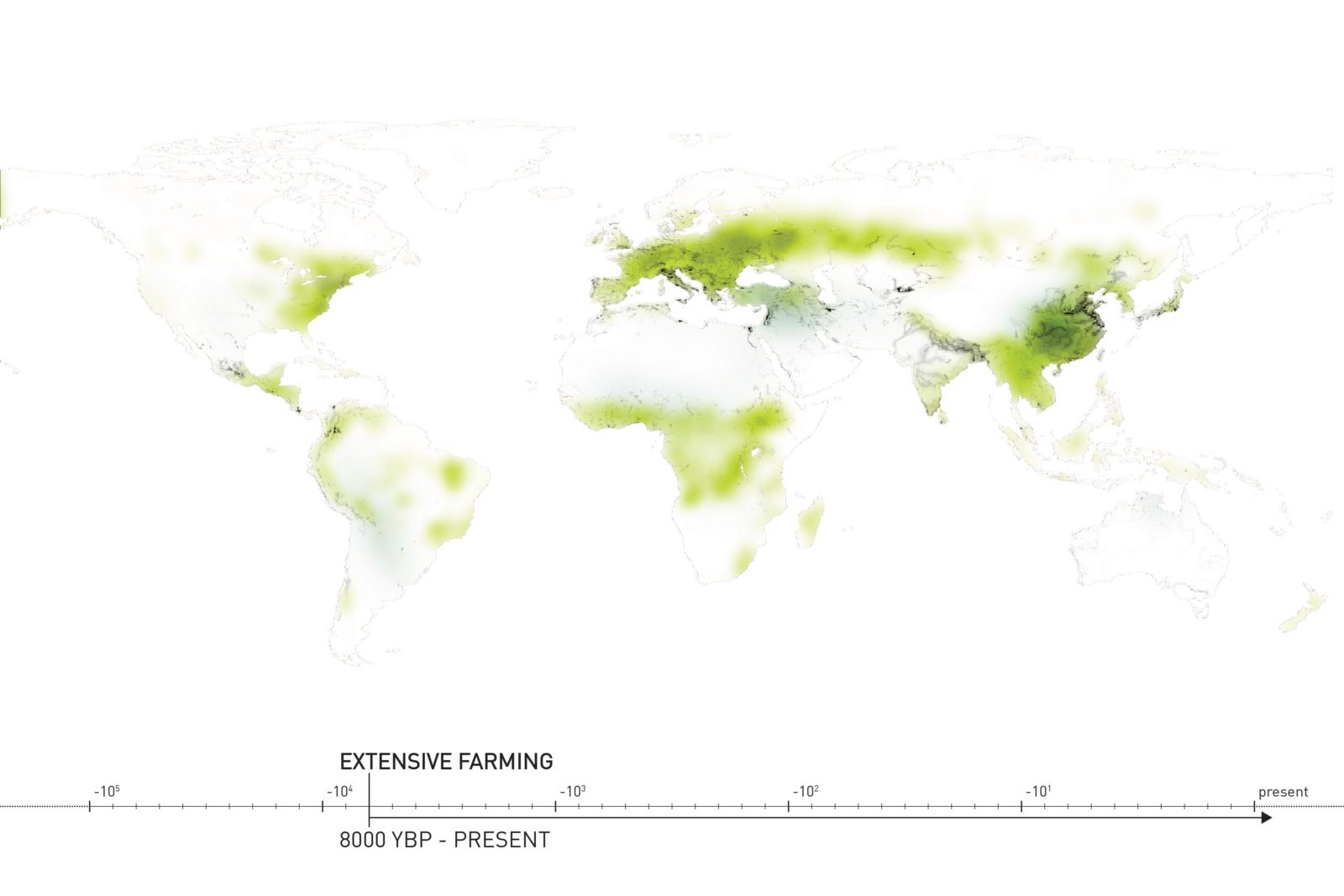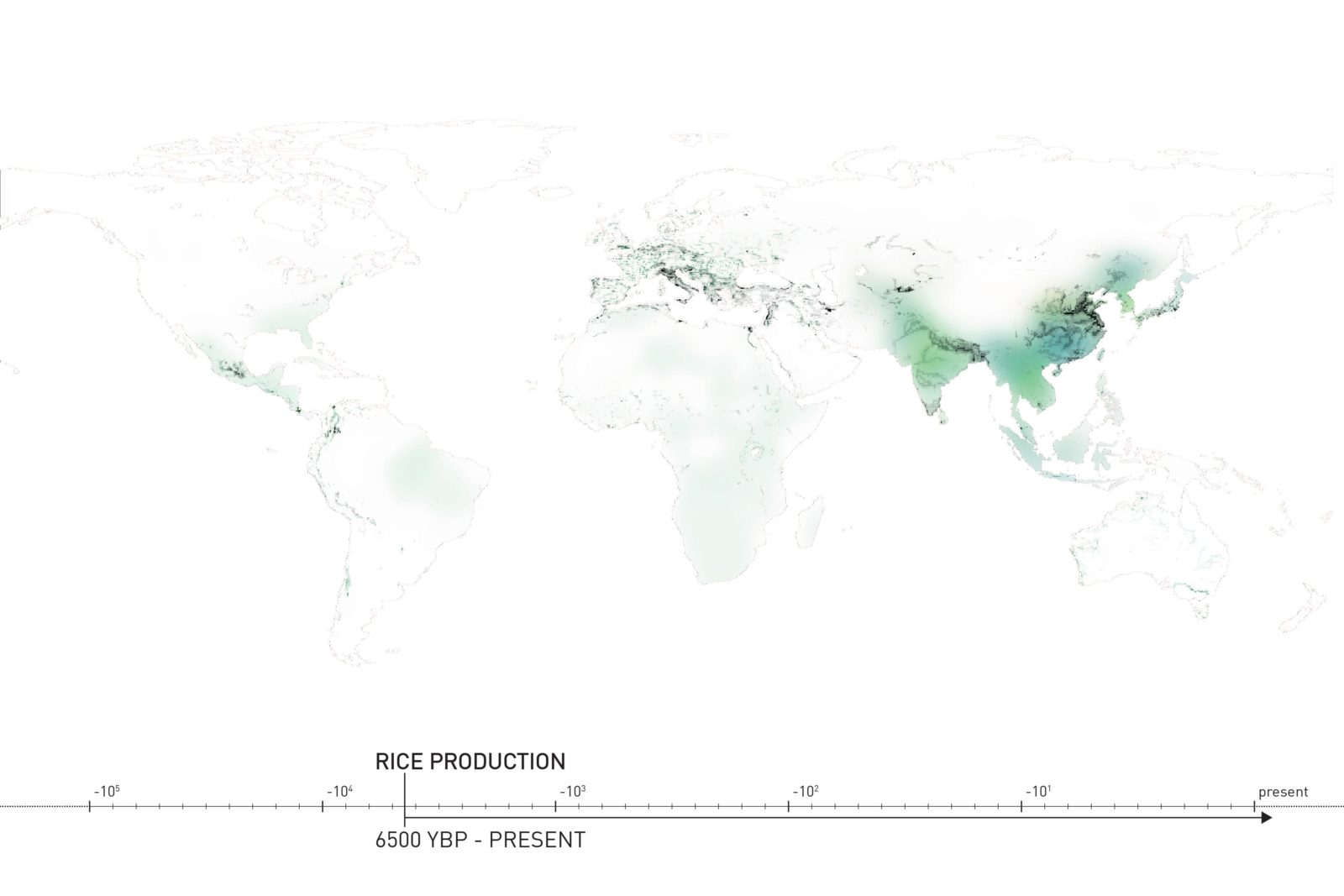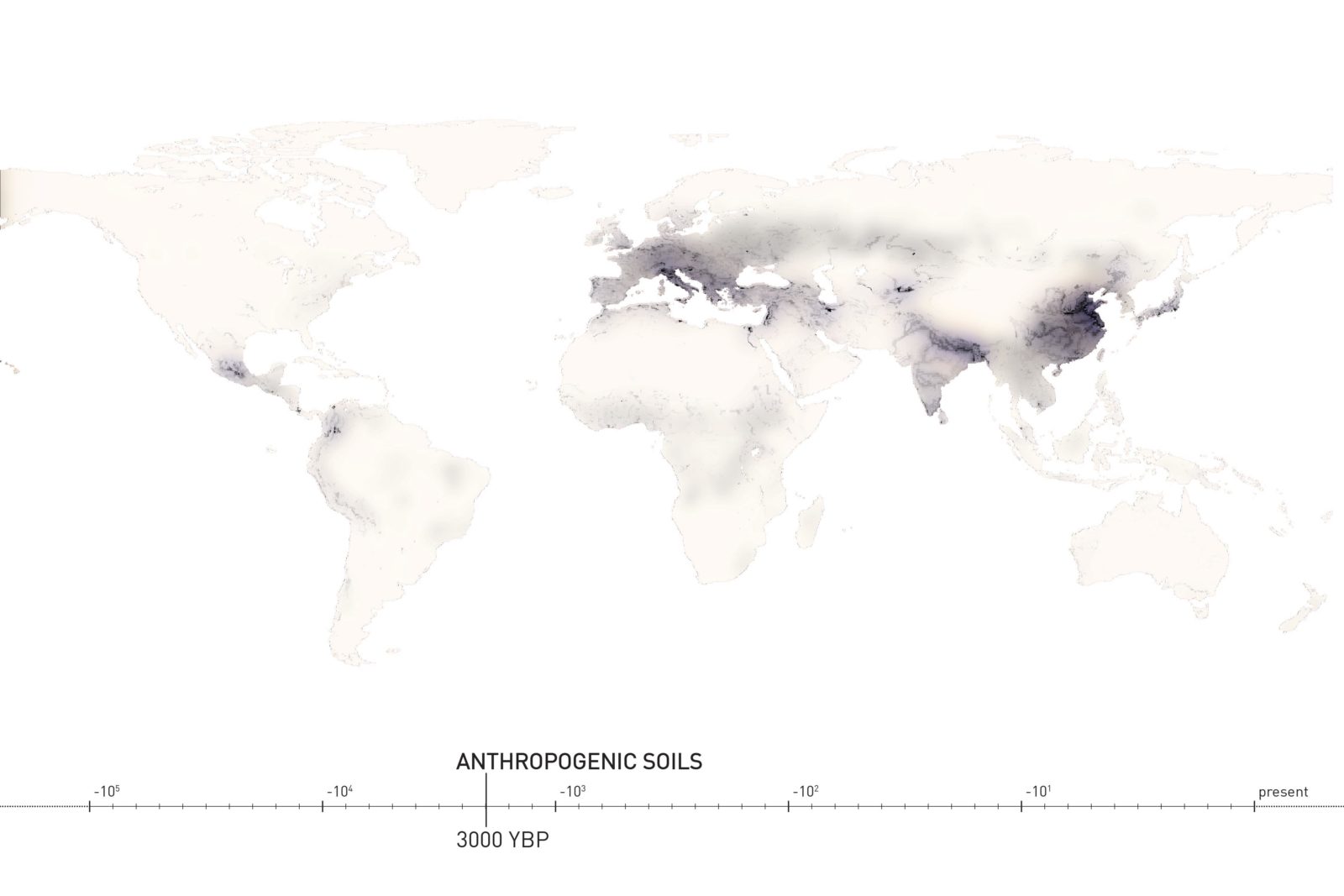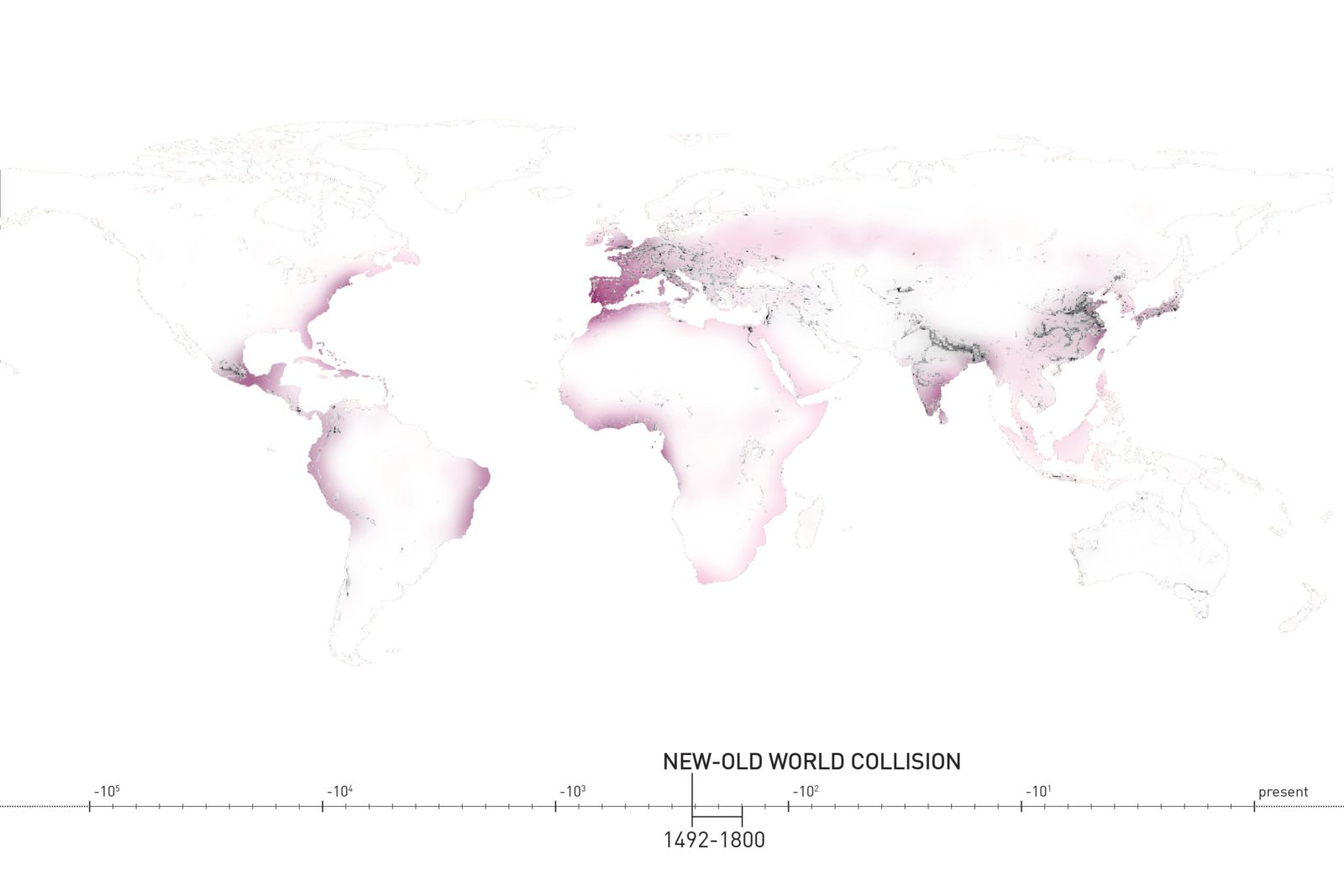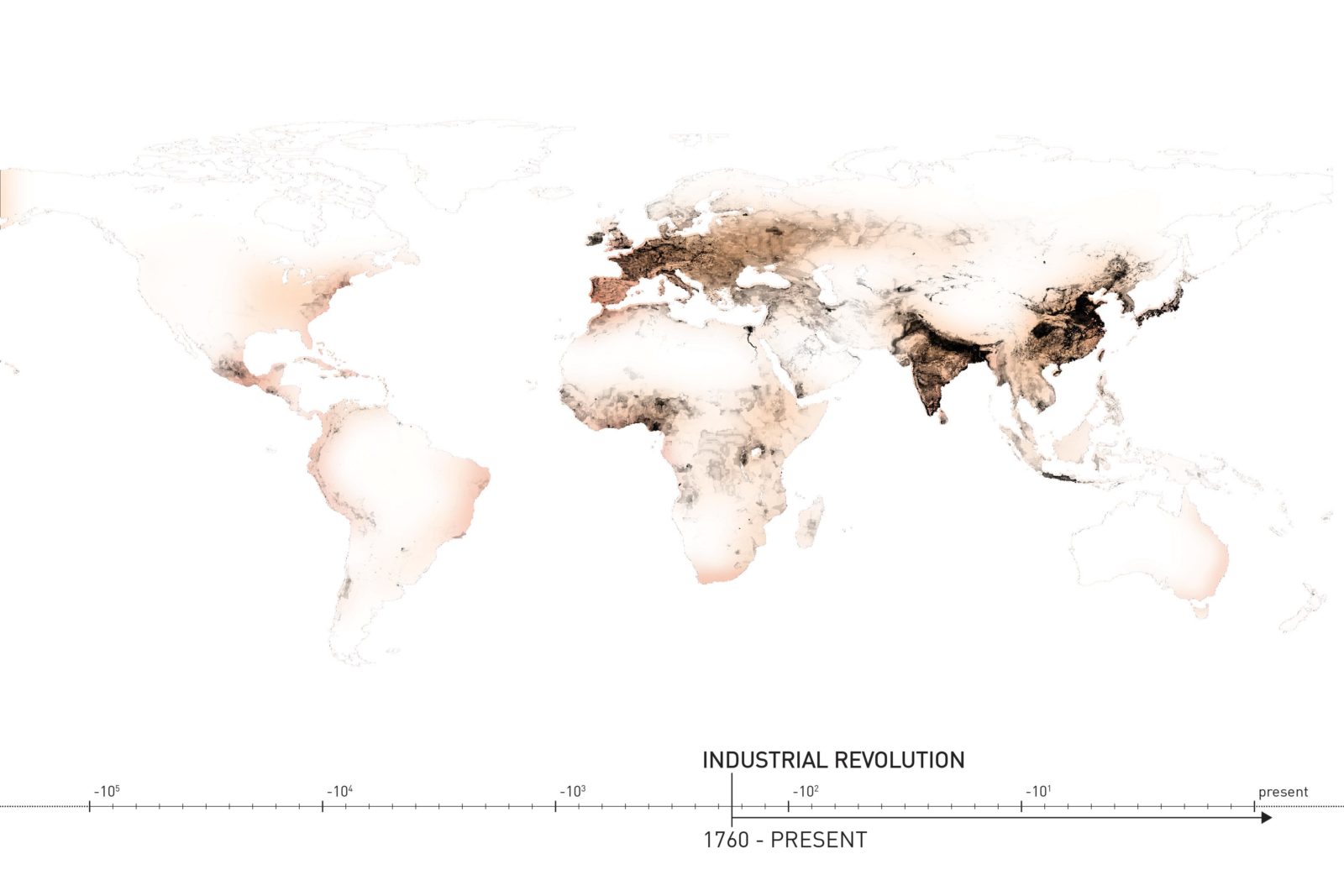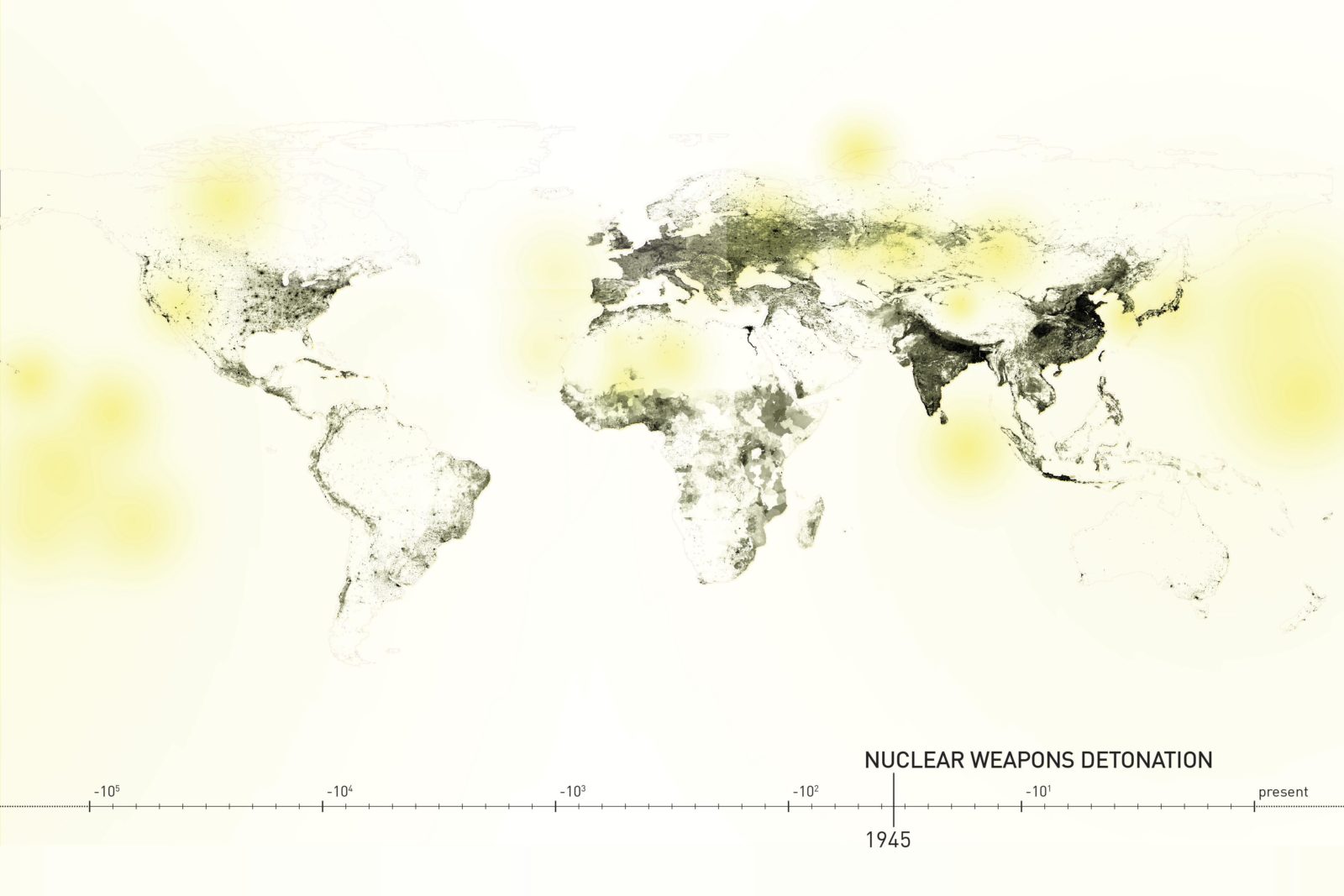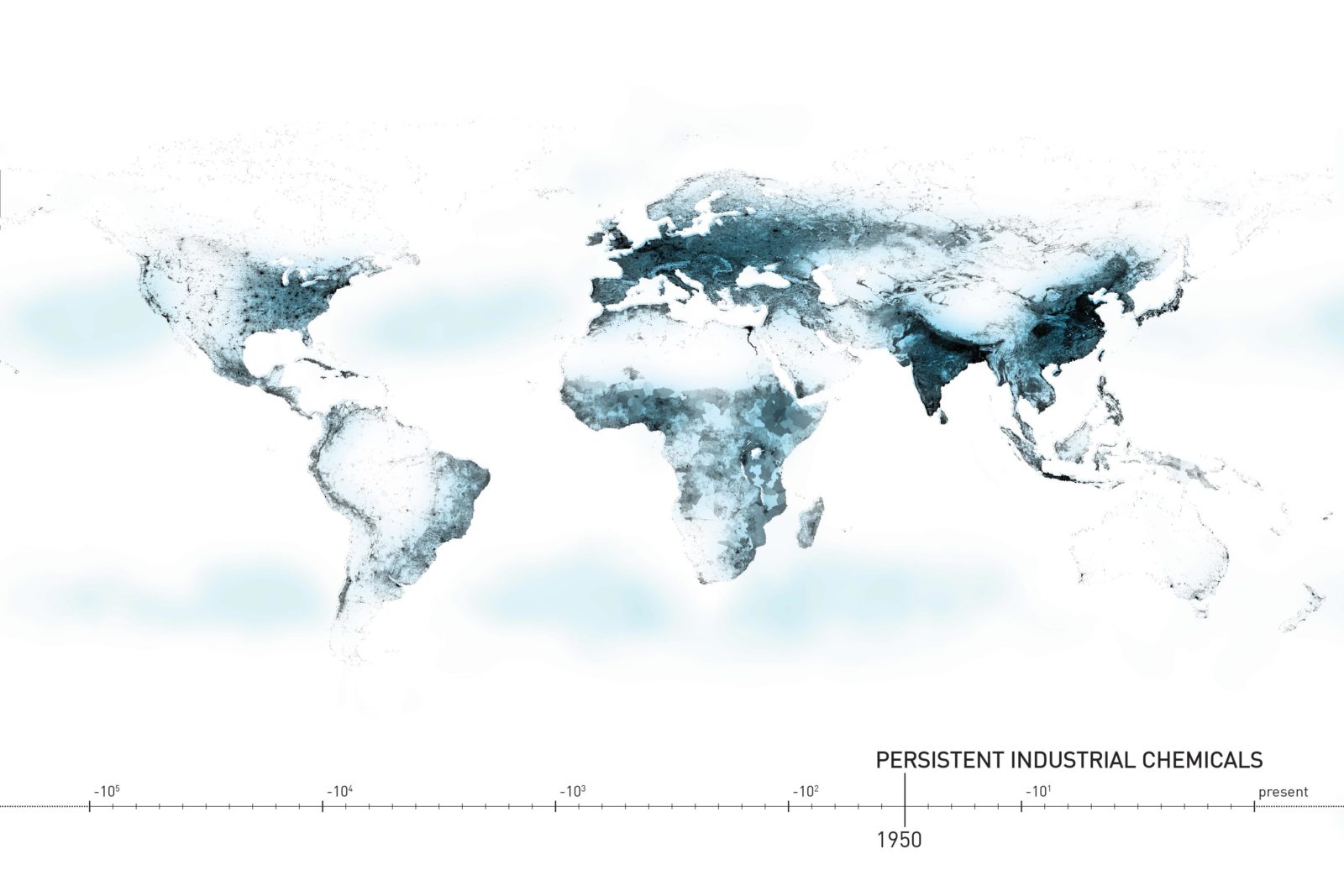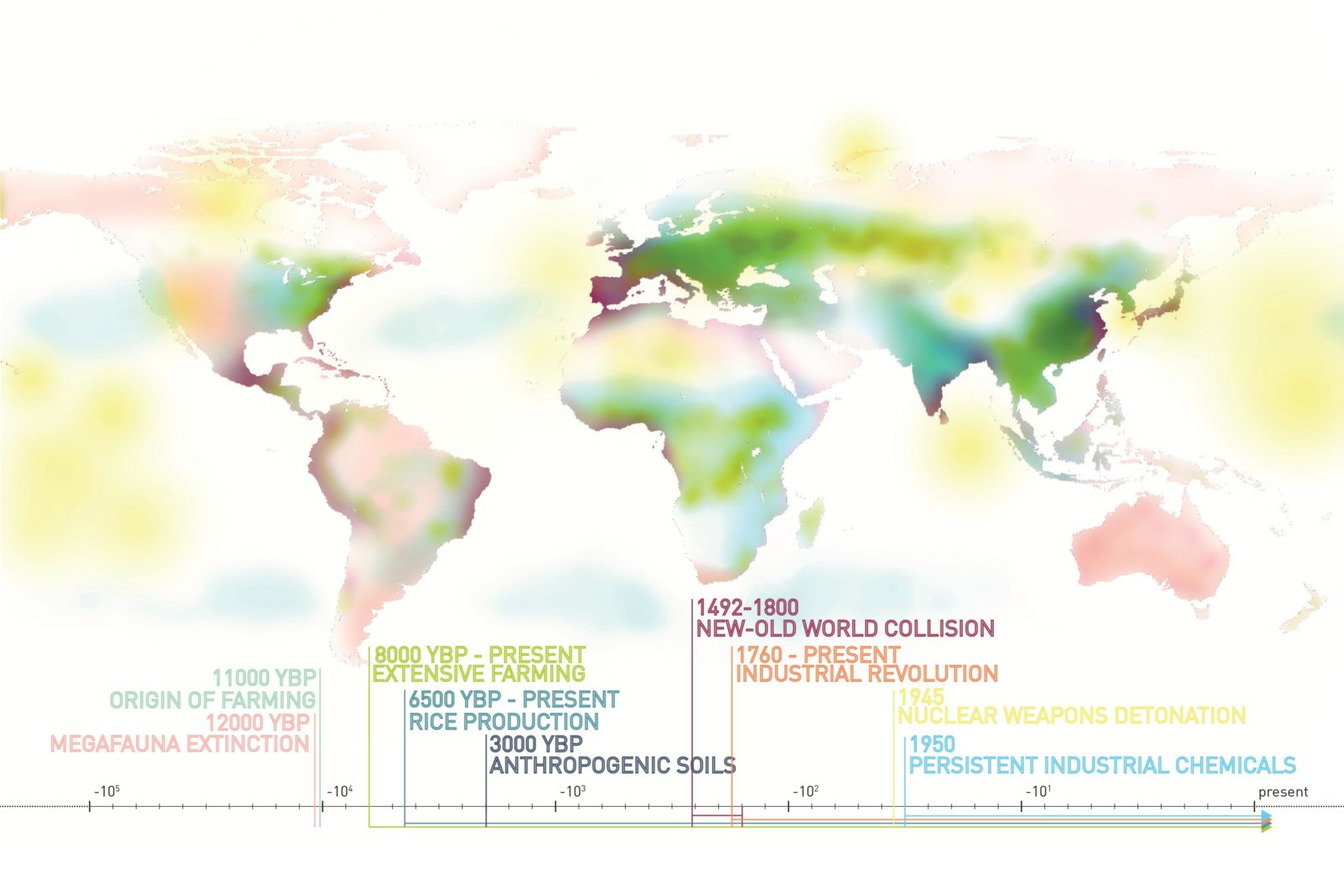Apr 23, 2016
13,000 Years of Messing Around with the Holocene
An Anthropocene Timeline
The debate about the exact date of birth of the Anthropocene is still under way. Whatever it will be (or rather, will have been), global-scale human influence goes back to prehistoric times. Christopher Reznich has compiled a small atlas that scales mankind’s tampering with the Earth’s spheres—from the global mega-fauna extinction to the spreading of persistent industrial chemicals.
Global Late Quaternary megafauna extinctions linked to humans, not climate change. The late Quaternary megafauna extinction was a severe global-scale event. Two factors, climate change and modern humans, have received broad support as the primary drivers, but their absolute and relative importance remains controversial. To date, focus has been on the extinction chronology of individual or small groups of species, specific geographical regions or macroscale studies at very coarse geographical and taxonomic resolution, limiting the possibility of adequately testing the proposed hypotheses. We present, to our knowledge, the first global analysis of this extinction based on comprehensive country-level data on the geographical distribution of all large mammal species (more than, or equal to 10 kg) that have gone globally or continentally extinct between the beginning of the Last Interglacial at 132,000 years BP and the late Holocene 1,000 years BP, testing the relative roles played by glacial–interglacial climate change and humans. We show that the severity of extinction is strongly tied to hominin palaeobiogeography, with at most a weak, Eurasia-specific link to climate change. This first species-level macroscale analysis at relatively high geographical resolution provides strong support for modern humans as the primary driver of the worldwide megafauna losses during the late Quaternary. SOURCE: Christopher Sandom, Søren Faurby, Brody Sandel, et al., “Global Late Quaternary megafauna extinctions linked to humans, not climate change,” 'Proceedings of the Royal Society B', 2014, 281 20133254, doi: 10.1098/rspb.2013.3254, published June 4, 2014 . The start of the period of large-scale human effects on this planet (the Anthropocene) is debated. The industrial view holds that most significant impacts have occurred since the early industrial era (~1850), whereas the early-anthropogenic view recognizes large impacts thousands of years earlier. This review focuses on three indices of global-scale human influence: forest clearance (and related land use), emissions of greenhouse gases (CO2 and CH4), and effects on global temperature. Because reliable, systematic land-use surveys are rare prior to 1950, most reconstructions for early-industrial centuries and prior millennia are hind casts that assume humans have used roughly the same amount of land per person for 7,000 years. But this assumption is incorrect. Historical data and new archeological databases reveal much greater per-capita land use in preindustrial than in recent centuries. This early forest clearance caused much greater preindustrial greenhouse-gas emissions and global temperature changes than those proposed within the industrial paradigm SOURCE: William F. Ruddiman, The Anthropocene. Annual Review of Earth and Planetary Sciences, vol. 41 (2013): pp. 45‒68. ADDITIONAL SOURCES: Bellwood, Peter, First Farmers: The origins of agricultural societes. Oxford: Wiley-Blackwell, 2004. Fuller, Dorian Q., “The Origins of agriculture,” General Anthropology, vol. 17, no. 1 (2010.): pp. 8–12. Humans have altered the Earth’s land surface since the Paleolithic mainly by clearing woody vegetation first to improve hunting and gathering opportunities, and later to provide agricultural cropland. In the Holocene, agriculture was established on nearly all continents and led to widespread modification of terrestrial ecosystems. To quantify the role that humans played in the global carbon cycle over the Holocene, we developed a new, annually resolved inventory of anthropogenic land cover change from 8,000 years ago to the beginning of large-scale industrialization (AD 1850). This inventory is based on a simple relationship between population and land use observed in several European countries over preindustrial time. Using this data set, and an alternative scenario based on the HYDE 3.1 land use data base, we forced the LPJ dynamic global vegetation model in a series of continuous simulations to evaluate the impacts of humans on terrestrial carbon storage during the preindustrial Holocene. Our model setup allowed us to quantify the importance of land degradation caused by repeated episodes of land use followed by abandonment. By 3 ka BP, cumulative carbon emissions caused by anthropogenic land cover change in our new scenario ranged between 84 and 102 Pg, translating to c. 7 ppm of atmospheric CO2. By AD 1850, emissions were 325–357 Pg in the new scenario, in contrast to 137–189 Pg when driven by HYDE. Regional events that resulted in local emissions or uptake of carbon were often balanced by contrasting patterns in other parts of the world. While we cannot close the carbon budget in the current study, simulated cumulative anthropogenic emissions over the preindustrial Holocene are consistent with the ice core record of atmospheric d13CO2 and support the hypothesis that anthropogenic activities led to the stabilization of atmospheric CO2 concentrations at a level that made the world substantially warmer than it otherwise would be. SOURCE: Jed O. Kaplan, Kristen M. Krumhardt, Earle C. Ellis, et al., “Holocene carbon emissions as a result of anthropogenic land cover change,” The Holocene, vol. 21 (2011): pp. 775–91. We review the origins and dispersal of rice in Asia based on a data base of 443 archaeobotanical reports. Evidence is considered in terms of quality, and especially whether there are data indicating the mode of cultivation, in flooded (“paddy” or “wet”) or non-flooded (“dry”) fields. At present it appears that early rice cultivation in the Yangtze region and southern China was based on wet, paddy-field systems from early on, before 4000 BC, whereas early rice in northern India and Thailand was predominantly dry rice at 2000 BC, with a transition to flooded rice documented for India at c. 1000 BC. On the basis of these data we have developed a GIS spatial model of the spread of rice and the growth of land area under paddy rice. This is then compared with a review of the spread of ungulate livestock (cattle, water buffalo, sheep, goat) throughout the Old World. After the initial dispersal through Europe and around the Mediterranean (7000–4000 BC), the major period of livestock expansion is after 3000 BC, into the Sub-Saharan savannas, through monsoonal India and into central China. Further expansion, to southern Africa and Southeast Asia dates mostly after 1000 BC. Based on these two data sets we provide a quantitative model of the land area under irrigated rice, and its likely methane output, through the mid to late Holocene, for comparison to a more preliminary estimate of the expansion of methane-producing livestock. Both data sets are congruent with an anthropogenic source of later Holocene methane after 3000 BC, although it may be that increase in methane input from livestock was most significant in the 3000–1000 BC period, whereas rice paddies become an increasingly significant source especially after 2000 BC SOURCE: Dorian Q. Fuller, Jacob van Etten, Katie Manning, et al., “The contribution of rice agriculture and livestock pastoralism to prehistoric methane levels: An archeological assessment,” The Holocene, vol. 21 (2011): pp. 743–59. Across a large proportion of Earth’s ice-free land surfaces, a solid-phase stratigraphic boundary marks the division between humanly modified ground and natural geological deposits. At its clearest, the division takes the form of an abrupt surface at the base of deposits variously called “artificial ground”, “anthropogenic ground” or “archaeological stratigraphy” – which together comprise a distinctive part of the geosphere called the “archaeosphere”. In other cases the bounding surface is more diffuse, gradational or mixed, due to action of non-human agencies and anthropedogenic forcings. It is alternately conformable and unconformable. Layers above typically contain artificial features, structures, artifacts and other material traces of human activity, in contrast to their relative absence in layers below. A fundamental characteristic of the boundary is that it is diachronous, still being formed and renewed today. In examining the boundary, this paper asks – does it reflect the diachronous onset and development of the Anthropocene itself? SOURCE: Matt Edgeworth, Dan DeB Richter, Colin Waters, et al., “Diachronous beginnings of the Anthropocene: The lower bounding surface of anthropogenic deposits,” The Anthropocene Review, vol. 2 no. 1 (2015): pp. 33‒58. The Columbian Exchange had such far-reaching effects that some biologists say that Colòn’s voyages marked the beginning of a new biological era: the Homogeocene. The term refers to homogenizing: mixing unlike substances to create a uniform blend. With the Columbian Exchange, places that were once ecologically distinct have become more alike. In this sense, the world has become one, exactly as the old admiral hoped […] The Homogeocene? A new epoch in the history of life brought into being by the abrupt creation of a world-spanning economic system? The claim seems grandiose. But imagine a thought experiment: flying around the earth in 1642, a century and a half after Colòn’s first voyage, threescore and ten after the first Chinese silk from Manila arrived in Mexico. Think of it as a round-the-world cruise at 35,000 feet of a planet in the first stages of a great disturbance. The brochure promises that the cruise will hit the highlights of the nascent Homogeocene. What will the passengers see? SOURCE: Charles C. Mann, How the Ecological Collision of Europe and the Americas Gave Rise to the Modern World. London: Granta, 2011[1943]. ADDITIONAL SOURCES: Diamond, Jared, Guns, Germs and Steel: A short history of everybody for the last 13,000 years. London: Chatto and Windus, 1997. Crosby, Alfred W., The Columbian Exchange: Biological and cultural consequences of 1492, 30th anniversary edn. Westport, CT: Preager, 2003. The human imprint on the global environment has now become so large and active that it rivals some of the great forces of Nature in its impact on the functioning of the Earth system. Although global-scale human influence on the environment has been recognized since the 1800s, the term Anthropocene, introduced about a decade ago, has only recently become widely, but informally, used in the global change research community. However, the term has yet to be accepted formally as a new geological epoch or era in Earth history. In this paper, we put forward the case for formally recognizing the Anthropocene as a new epoch in Earth history, arguing that the advent of the Industrial Revolution around 1800 provides a logical start date for the new epoch. We then explore recent trends in the evolution of the Anthropocene as humanity proceeds into the twenty-first century, focusing on the profound changes to our relationship with the rest of the living world and on early attempts and proposals for managing our relationship with the large geophysical cycles that drive the Earth’s climate system. SOURCE: Will Steffen, Jacques Grinevald, Paul Crutzen, et al., “The Anthropocene: Conceptual and historical perspectives,” Philosophical Transactions of the Royal Society A: Mathematical, Physical and Engineering Sciences, no. 369 (2011): pp. 842‒67. Global-scale enrichment in artificial radioisotopes has resulted from atmospheric nuclear weapon testing, mainly from 1945 to 1980[…], with more localized, although still widespread, signatures associated with discharges from nuclear reactors (Gałuszka et al. 2013; Hancock et al. 2014). There is a 137 Cs fallout peak of 1963 – 1964 (mainly in northern hemisphere sediments) and a more globally exten- sive peak in 1964 for 239 Pu. Ice cores show jumps in beta-radioactivity in 1954 and 1964, with a peak in 1966 that is a factor of 100 above background levels (Wolff 2013) . Speleothems record a wide- spread and unambiguous radiocarbon signal that commenced in 1955 and peaked in 1962, relating to atmospheric nuclear testing. Following the test-ban treaty, levels of 14 C in the atmosphere have declined exponentially (Fairchild & Frisia 2013). This signature has been recorded in corals and salt marshes. However, it is probably the initial post-1945 rise in concentrations that would be used to mark a putative base of the Anthropocene, rather than the peak signature. SOURCE:Colin N. Waters, Jan A. Zalasiewicz, Mark Williams, et al., “A stratigraphical basis for the Anthropocene?,” in Waters, Zalasiewicz, and Williams (eds), A stratigraphical basis for the Anthropocene? London: Geological Society Special Publications, no. 395, 2014, pp. 1–21. Anthropogenic chemical contamination is one of the most evident signals of human influence on the environment. The large amounts of industrially produced pollutants that have been introduced, over decades, into air, soil and water have caused modifications to natural elemental cycling. Anthropogenic contamination usually leads to enrichment in many elements, particularly in industrial areas. Thus, certain elements and their isotopes can be used as geochemical tracers of anthropogenic impact. Some human-induced changes in the environment may be regarded as a secondary effect of pollution, such as acidification, which causes increased geochemical mobility of several trace elements in surficial deposits. Methods used by geochemists to assess the scale of anthropogenic influence on the environment include calculations of anthropogenic influence on the environment via enrichment and contamination factors, geoaccumulation index and pollution load index. The use of geochemical background levels for delineating between natural and anthropogenic pollution is important. A historical perspective of anthropogenic contamination, allied with isotopic and geochemical signatures in dated sediment cores, may be applied to help define the Anthropocene. SOURCE: Agnieska Gałuszka, Zdzisław M. Migaszewski, and Jan Zalasiewicz, “Assessing the Anthropocene with geochemical methods,” in Colin N. Waters, Jan A. Zalasiewicz, Mark Williams, et al. (eds), A Stratigraphical basis for the Anthropocene? London: Geological Society Special Publications, 395, 2014, pp. 221–38.
